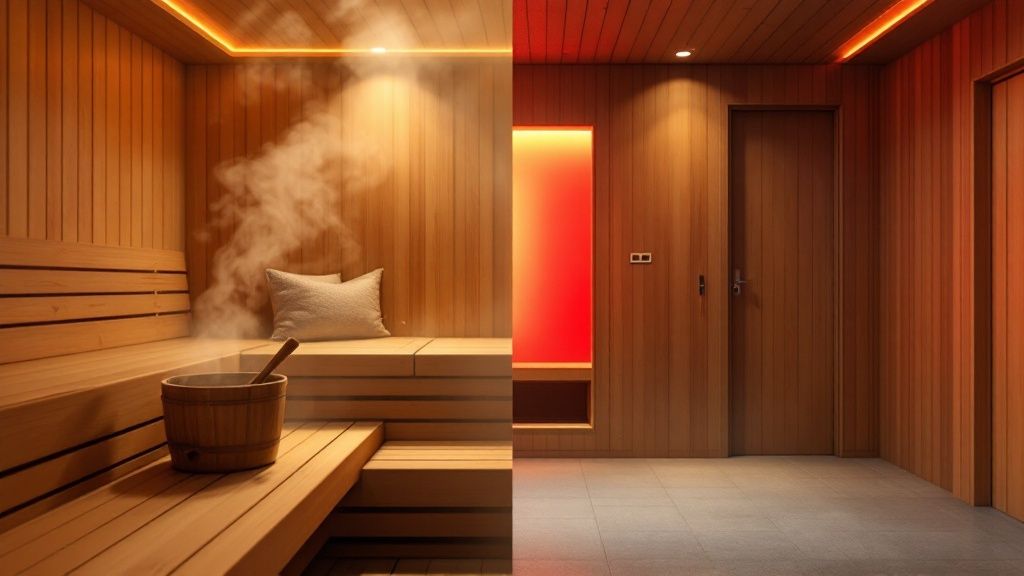
Difference Between Steam and Infrared Sauna: Which Is Better?
The real difference between a steam sauna and an infrared sauna boils down to one simple thing: a steam sauna heats the air around you, while an infrared sauna heats your body directly. This isn't just a technical detail—it’s the key to two completely different wellness experiences, each with its own unique feel and set of benefits.
Steam vs. Infrared Sauna: The Core Differences
Choosing between these two isn't just about picking a hot room. It’s about matching the technology to your personal health goals. The way each one makes you sweat fundamentally shapes the entire experience, from the atmosphere inside to the feeling you have when you step out.
Traditional steam saunas, with deep roots in ancient bathing cultures, work by pouring water over hot rocks to create a wave of thick, moist steam. Infrared saunas are a more recent innovation, using specialized emitters to produce radiant heat that works on your body from the inside out.
Let's get straight to what sets them apart:
- How They Heat: Steam saunas rely on convective heat—superheating the air, which then warms your body. Infrared saunas use radiant heat, where infrared waves penetrate your skin and warm you directly.
- How They Feel: A steam room hits you with an intense, enveloping, humid heat that feels amazing for clearing your airways. An infrared session is much gentler, offering a dry warmth that’s perfect for longer, more meditative sessions focused on deep tissue relief.
A Tale of Two Temperatures
The biggest practical difference you'll feel is the environment inside. A traditional steam sauna cranks the temperature up to between 70°C and 85°C with nearly 100% humidity. It's a powerful, primal experience.
On the other hand, modern infrared saunas operate at much lower, more comfortable temperatures, typically between 46°C and 57°C. The environment is dry and the heat feels less aggressive, allowing you to relax for longer. If you want to dig deeper, you can discover more about how these heating methods compare and what they mean for your personal sauna sessions.
This chart drives the point home, showing just how different the two experiences are.
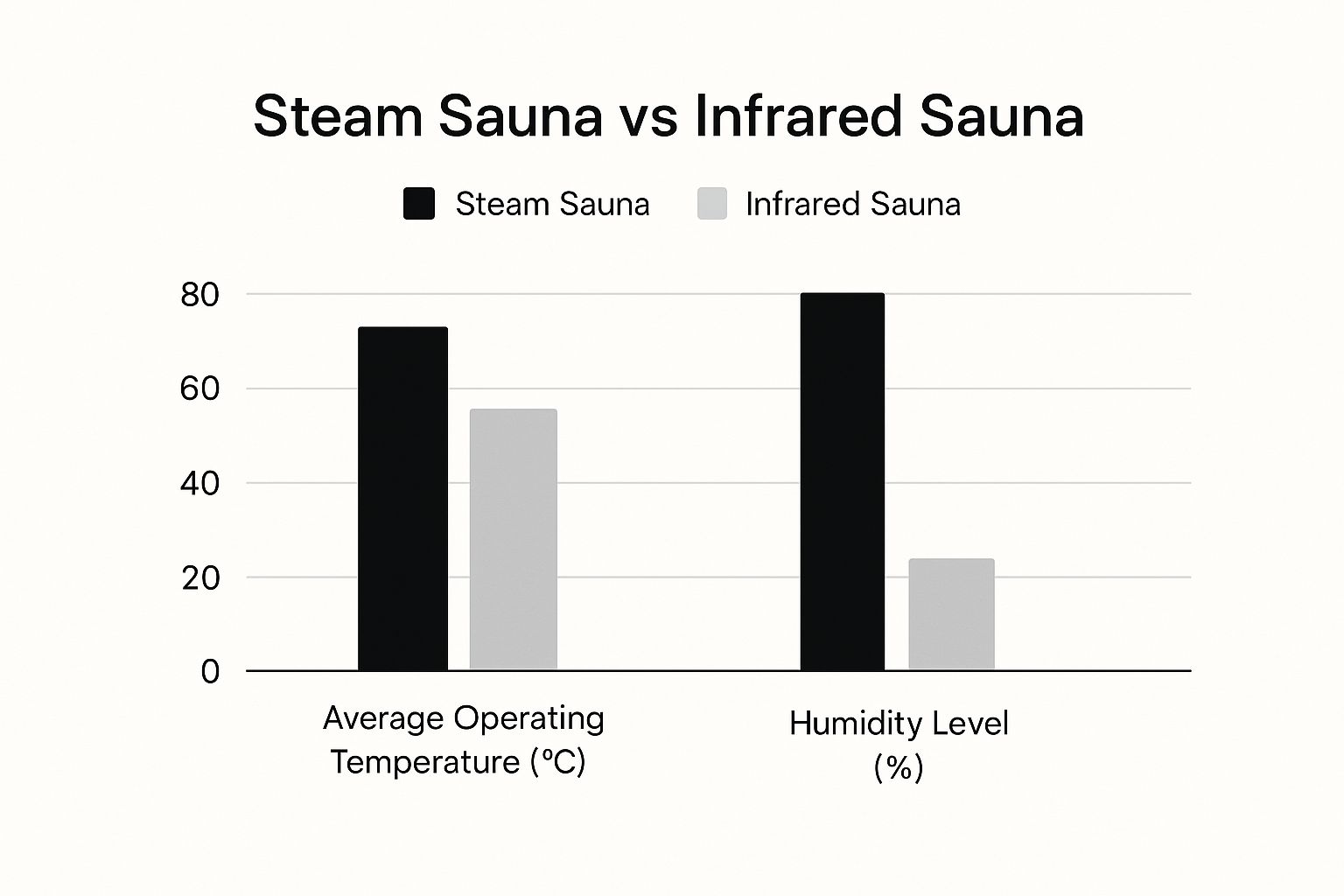
As you can see, we're talking about two completely different worlds. One is a hot, steamy oasis, while the other is a gentle, dry warmth.
Key Differences at a Glance: Steam vs. Infrared Sauna
Sometimes you just need a quick, side-by-side comparison. This table gives you an immediate snapshot of what sets steam and infrared saunas apart, stripping away the noise to show you the core distinctions.
| Characteristic | Traditional Steam Sauna | Modern Infrared Sauna |
|---|---|---|
| Heat Source | Electric or wood heater warms rocks to produce steam | Infrared emitters (carbon or ceramic) produce light |
| Air Temperature | High (70°C - 85°C) | Low (46°C - 57°C) |
| Humidity Level | Very High (near 100%) | Very Low (10-20%) |
| Sensation | Intense, moist heat on the skin | Gentle, deep-penetrating warmth |
| Heat-Up Time | Longer (30-45 minutes) | Shorter (10-20 minutes) |
Getting a handle on these key differences is the first real step toward picking the right sauna for your home and lifestyle.
For a reliable, high-quality option that’s built to last, you need to see the Mande Spa Outdoor collection. These saunas ship directly from within the USA, so you can be sure you're getting a premium product instead of a lower-quality import. There’s never been a better time to invest in your wellness and purchase the sauna you've been dreaming of.
How Each Sauna Delivers Heat to Your Body
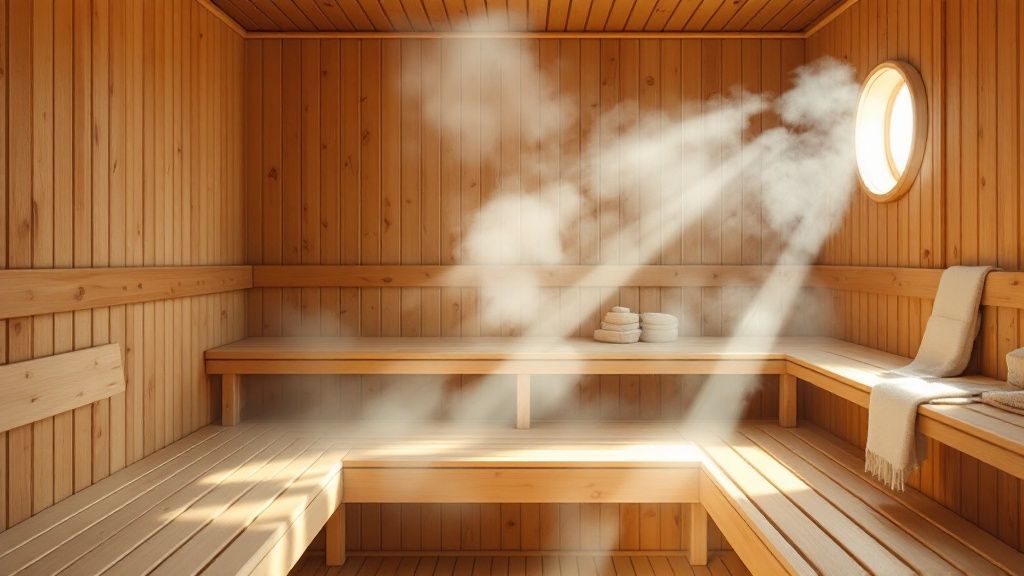
The single biggest difference between a steam and infrared sauna is how they get you hot. One heats the room around you like an oven, and the other warms you directly from the inside out, much like the sun's rays. This core distinction creates two entirely different atmospheres and therapeutic experiences.
A traditional steam sauna works through convective heat. It uses a special heater—known in Finland as a kiuas—to get a pile of rocks scorching hot.
When you ladle water over those stones, it explodes into a burst of steam called löyly. This steam floods the room, pushing the air temperature up to a blistering 70°C to 85°C and cranking the humidity to nearly 100%. The air gets hot first, and then that intensely hot, moist air heats your body.
The Power of Convective Heat
Think of it like a conventional oven. The heating elements warm the air, and that hot air cooks the food. A steam sauna does the same thing to your body. The heater warms the air, and you absorb that heat from the super-heated environment around you.
This creates an immediate, intense, all-encompassing warmth that you feel on your skin. It’s a powerful sensation that triggers a heavy, surface-level sweat as your body fights to cool itself down in the hot, humid air.
Infrared saunas, on the other hand, use a completely different method: radiant heat. Instead of a rock heater, they use special emitters that produce infrared light waves.
These light waves travel through the air without really heating it up. Instead, they penetrate your skin to gently and directly warm your body's tissues. This is why the air temperature inside an infrared sauna can be much more manageable, typically sitting between 46°C and 57°C with very little humidity.
Radiant Heat Explained
To get a feel for radiant heat, picture yourself standing outside on a cool, sunny day. The air might be crisp, but you can feel the sun’s warmth on your skin. That’s radiant heat in action. The sun is warming you directly, not the air.
An infrared sauna works the exact same way. It skips heating the air and delivers warmth deep into your muscles and joints. This produces a very different kind of sweat—one that feels like it’s coming from your core.
The core distinction is simple yet profound: A steam sauna heats you from the outside-in, using hot air as the medium. An infrared sauna heats you from the inside-out, using radiant light to warm your body directly.
This difference in heat delivery is what shapes the entire sauna experience. The choice isn't just about temperature preferences; it's about how you want to feel the heat. Do you crave the intense, traditional embrace of hot, steamy air, or do you prefer the gentle, deep-penetrating warmth of infrared light?
Understanding this key difference between steam and infrared saunas is the first step to choosing the right wellness tool for you. To see premium saunas built for an exceptional experience, check out the collection at Mande Spa Outdoor. All their models are high-quality, durable units that ship from within the USA, so you're not getting a lesser-quality import. Now is the perfect time to purchase a sauna and invest in your health.
Choosing a Sauna Based on Your Health Goals
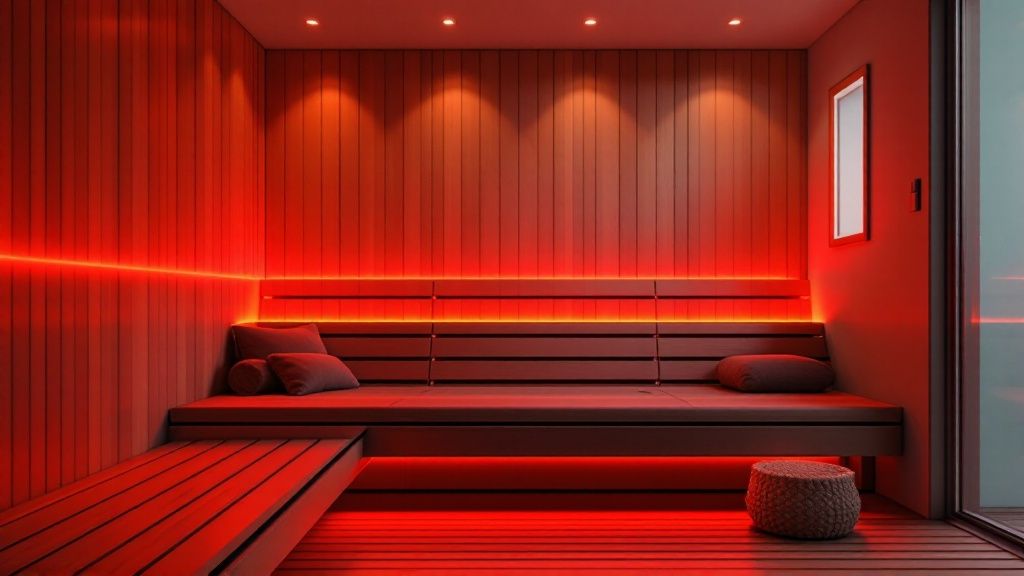
The real difference between steam and infrared sauna technology isn't just about heat; it's about the unique health outcomes each one delivers. The best way to choose is to think about your wellness priorities. It’s not a question of which sauna is better overall, but which one is a perfect match for your body and the results you're chasing.
A traditional steam sauna hits you with a wave of intense, humid heat. That environment is fantastic for respiratory relief. If you're dealing with allergies or sinus congestion, the warm, moist air can feel like a miracle, opening up your airways and soothing irritation. This powerful heat also gives your skin a deep, surface-level cleanse by opening up your pores for a heavy, purifying sweat.
On the flip side, an infrared sauna offers a completely different kind of warmth. Instead of heating the air around you, its radiant heat penetrates deep into your body’s tissues. This makes it a go-to for athletes and anyone managing chronic pain.
Relief for Aches and Pains
If your primary goal is to soothe sore muscles or ease stiff joints, you'll want to lean toward an infrared sauna. Its deeply penetrating heat gets right to work on muscles and joints, boosting blood flow exactly where you need it most.
This targeted circulation helps you bounce back faster from a tough workout and can offer incredible relief from the chronic aches of conditions like arthritis. Many people say they feel a real difference in stiffness and mobility after just a few consistent sessions. You can dive deeper into the science behind this in our guide on what infrared sauna therapy is and how it targets physical discomfort.
The feeling is less like an aggressive, skin-level heat and more like a gentle, therapeutic warmth that radiates from your core. It's a game-changer for targeted pain management.
The decision often comes down to this: Choose steam for surface-level benefits like respiratory and skin cleansing, or choose infrared for deep-tissue benefits like muscle recovery and joint pain relief.
Cardiovascular and Detoxification Support
Both sauna types will get your heart pumping and make you sweat, which is your body's natural way of detoxing. But how they get you there is quite different, and that affects the experience and the results.
The intense heat of a steam sauna makes you sweat hard and fast. This is perfect for a powerful, quick detoxification session where the main goal is to simply sweat out as much as possible.
Infrared saunas, however, produce a different kind of sweat. Because the heat goes deeper, it’s thought to pull out a higher concentration of toxins, rather than just the water-based sweat you get in a steam room.
Infrared saunas heat the body more directly—penetrating about 1.5 inches into tissues. Some research suggests this may offer enhanced cardiovascular benefits, like better circulation, and more effective pain relief for muscle soreness. The sweat rate in an infrared sauna is often compared to moderate exercise, which is linked to both detoxification and burning calories.
Matching the Sauna to Your Lifestyle
Let's put this into practice with a couple of real-world examples:
-
The Athlete: After a grueling workout, an athlete needs to calm deep muscle fatigue and reduce inflammation. The infrared sauna is their best friend. Its radiant heat targets those sore muscles directly, helping them recover faster and get back in the game.
-
The Allergy Sufferer: Someone fighting off seasonal allergies and sinus pressure would find immediate comfort in a steam sauna. The warm, humid air is a natural decongestant, opening up nasal passages for easier breathing.
Ultimately, your personal wellness journey is the deciding factor. By aligning the unique strengths of each sauna with your specific needs, you're making a smart investment in your long-term health. Don't forget to visit Mande Spa Outdoor to see top-quality, USA-shipped saunas that can help you reach your goals.
Getting Real: What It Takes to Install and Maintain a Sauna
Let's move past the heat and health perks for a minute and talk about the practical side of owning a sauna. This is where the difference between steam and infrared sauna ownership truly hits home. The day-to-day reality of installation and upkeep can make or break your experience, so it’s critical to know what you’re getting into.
Simply put, one is a construction project, and the other is more like assembling furniture.
A traditional steam sauna isn't just a box you put in a room; it’s a room you have to build. Think of it as adding a small, specialized bathroom to your house. This is almost never a DIY job. You're looking at a full-on project involving framing, high-voltage electrical work, and, most importantly, serious plumbing and drainage to handle all that steam.
This isn’t a weekend warrior task. The entire room has to be sealed up tight with a vapor barrier to keep moisture from creeping into your walls. Get that wrong, and you’re setting yourself up for a nightmare of mold, mildew, and structural damage down the road.
The Headaches of Steam Sauna Installation
Managing that intense, wet heat is the biggest hurdle. A typical steam room build involves a team of pros:
- Dedicated Electrical: That powerful heater needs its own 240-volt circuit, which means you’re calling an electrician.
- Plumbing and Drainage: You need a water line run to the steam generator and a proper floor drain installed. That’s a job for a plumber.
- Vapor Barrier: A special waterproof membrane has to be meticulously installed behind the walls and ceiling. This is non-negotiable.
- Proper Ventilation: You also need an effective ventilation system to clear the air and help the room dry out between sessions.
This complexity adds a hefty sum to the total cost and can turn the installation into a lengthy process. Infrared saunas, on the other hand, are a completely different story.
The Simplicity of Infrared Sauna Assembly
Most infrared saunas are built with the homeowner in mind. They usually arrive as a set of pre-fabricated panels that you can put together yourself. Many use simple clasp or buckle systems, meaning two people can assemble the whole thing in an afternoon with just a few basic tools.
But here’s the real kicker: a huge number of infrared models are designed to plug right into a standard 120-volt household outlet. This is a massive advantage. You completely bypass the need for an electrician, making the entire setup process incredibly straightforward and accessible.
The core difference in installation is this: a steam sauna is a construction project requiring multiple professional trades, while an infrared sauna is an appliance you can assemble and plug in yourself.
This accessibility makes infrared a go-to choice for anyone who wants a sauna without the chaos of a home renovation. The long-term maintenance story follows the exact same pattern.
Keeping a steam room clean is a constant chore. The moist environment is a perfect breeding ground for mold and mildew, so you have to stay on top of regular, thorough cleanings.
Because infrared saunas are dry, their upkeep is a breeze. A quick wipe-down of the benches and interior with a damp cloth after you're done is pretty much all it takes. This makes the day-to-day ownership experience far less of a burden.
To sidestep these potential headaches, your best bet is to purchase a well-engineered unit from the start. The saunas from Mande Spa Outdoor are a perfect example. They’re designed for simple installation and built to last. Since they ship from within the USA, you can feel confident you’re getting a high-quality product, not a cheap import that will cause problems later. Choose a sauna that fits your home and your life, not one that creates more work.
Evaluating the True Cost of Ownership and Efficiency
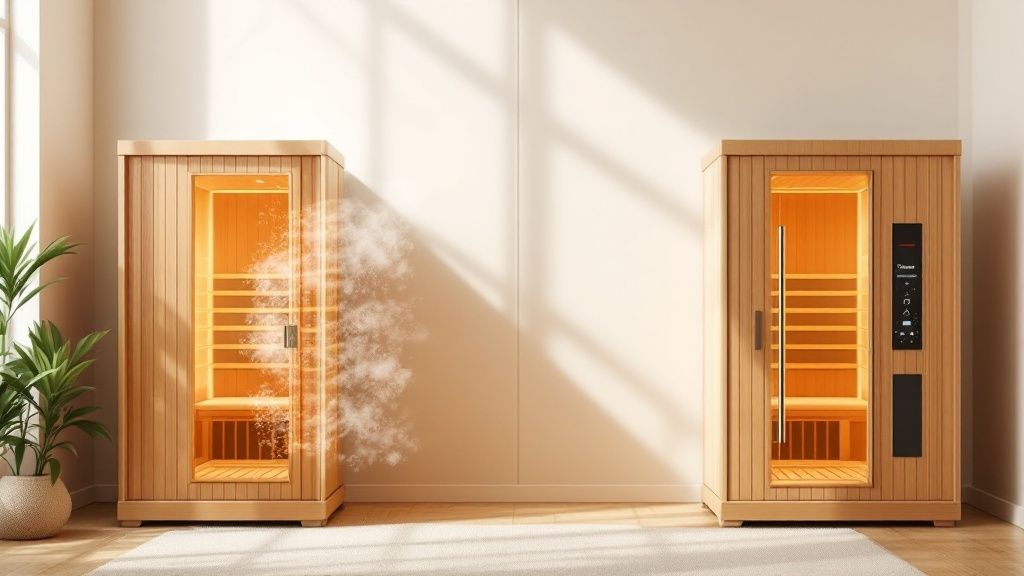
When you're deciding between a steam and an infrared sauna, the initial price tag is just the first chapter. To really understand the financial picture, you have to look at the total cost of ownership—from the day it's installed to what it adds to your monthly utility bill. This is where the difference between steam and infrared sauna technology really hits your wallet.
Right away, you'll notice a custom-built steam sauna typically comes with a higher upfront cost. It’s a construction project, plain and simple. You're looking at professional plumbing, drainage, and specific electrical work, which can make the initial investment pretty hefty. Infrared saunas, on the other hand, are usually sold as prefabricated kits, making them much more approachable from a budget standpoint.
But the real story of savings with an infrared sauna unfolds long after you’ve bought it, showing up every time you flip the switch.
Unpacking Energy Efficiency and Operating Costs
The long-term financial edge of an infrared sauna lies squarely in its energy efficiency. This isn't just a minor detail; it's a core design advantage driven by two things: quicker heat-up times and lower operating temperatures.
A traditional steam sauna needs a good 30 to 45 minutes to build up that intense, steamy heat, and it’s chugging electricity that whole time.
In contrast, an infrared sauna is often ready to go in just 10 to 20 minutes. That shorter pre-heating time means you're not wasting energy just waiting around. Over the weeks, months, and years of regular use, those saved minutes add up to real money back in your pocket.
On top of that, infrared saunas run at a much milder 46°C to 57°C, a far cry from the blistering 70°C to 85°C of a steam room. Simply put, it takes a lot less power to maintain that lower temperature, making every single session cheaper to run.
The true cost isn't just the price you pay today, but the price you pay every time you turn it on. The energy efficiency of an infrared sauna makes it a more cost-effective wellness tool for long-term, regular use.
A Smart Investment in Your Home
When you weigh all these factors, it’s clear an infrared sauna isn’t just a tool for your health—it’s also a smarter financial move. The lower barrier to entry combined with continuous savings on electricity makes it the more economical choice over the long haul. For a deeper dive into what to budget, our guide on sauna installation costs offers some excellent real-world insights.
This is exactly why investing in a high-quality unit makes all the difference. When you're ready to make a choice, you'll find that models built with performance in mind deliver the best value. We highly recommend visiting Mande Spa Outdoor to purchase an American-shipped sauna. They are engineered for efficiency and durability, ensuring your investment pays you back in both health benefits and energy savings for years to come.
So, Which Sauna Is Right for Your Home?
Choosing between a steam sauna and an infrared sauna really boils down to what you want out of the experience. It’s less about which one is “better” and more about which one fits your life and your wellness goals. After breaking down how they work, the health benefits, and what it takes to own one, the right choice for you should start coming into focus.
Think about it this way: if you're drawn to the classic, powerful ritual of a sauna, a steam sauna is probably calling your name. It’s for those who love that wave of intense, humid heat that opens up the airways and makes you feel completely refreshed. It's a social, invigorating experience that people have treasured for generations.
But for many people setting up a wellness space at home today, the priorities look a little different.
The Modern Homeowner’s Choice
If you're looking for deep therapeutic benefits, daily convenience, and a smart long-term investment, the infrared sauna is hard to beat. Picture this: you finish a tough workout and need deep relief for your aching muscles, or you want to ease chronic joint pain without overwhelming heat. That’s the magic of infrared.
The gentle, direct heat lets you stay in longer for a more meditative session, and the "plug-and-play" installation is a game-changer. It delivers targeted results like muscle recovery and detoxification with incredible efficiency. For anyone who wants a straightforward, low-maintenance wellness tool that delivers consistently, the infrared sauna is the clear winner. It's no wonder so many are looking into modern saunas for home to elevate their daily routines.
For the modern homeowner seeking maximum therapeutic benefit with superior efficiency and ease of use, an infrared sauna is the superior investment. It delivers deep, targeted wellness results without the high costs and maintenance demands of traditional steam.
This decision is about more than just a list of features; it's an investment in a tool that will support your health for years to come. That’s why where your sauna comes from is so important. Many of the cheaper imports cut corners, which can lead to frustrating performance and durability issues down the road.
Opting for an American-shipped sauna is a vote for higher craftsmanship. Brands like Mande Spa Outdoor offer premium saunas shipped from within the USA, giving you the quality, support, and reliability that many imported alternatives just can't promise. Now is the perfect time to purchase a sauna and make a real investment in your well-being.
Your Top Sauna Questions Answered
When you're deciding between a steam sauna and an infrared model, a few key questions always pop up. Let's tackle them head-on so you can feel completely confident in your choice.
A big one is always session time. Because traditional steam saunas operate at such high temperatures, sessions are usually short and intense—think 15-20 minutes. Infrared saunas, on the other hand, use a gentler heat that warms you from the inside out, making it comfortable to relax for longer sessions of 30-45 minutes.
Can I Get Steam in an Infrared Sauna?
That’s a firm no. Infrared saunas are built for dry heat, period. Their whole technology is based on radiant heat that directly warms your body, not the surrounding air.
Trying to create steam by adding water would not only be ineffective, but it could seriously damage the sensitive infrared emitters and electrical systems. If you're chasing that authentic, humid löyly—the Finnish term for the steam that rises from the hot rocks—then a traditional steam sauna is your only real option.
Which Is Better for a Small Space?
For anyone working with limited square footage, an infrared sauna is almost always the smarter choice. They're designed for modern homes, often sold as self-contained, pre-fab kits that can tuck neatly into a corner or even a large closet.
The real advantage is the lack of infrastructure needed. An infrared sauna just needs an electrical outlet. Steam saunas require plumbing, drainage, and dedicated ventilation, turning the installation into a significant construction project.
When it comes to home installation, the difference is stark. Infrared saunas offer plug-and-play convenience for existing spaces. A steam sauna is a built-in feature that demands professional planning and construction from the start.
This makes infrared models a much more practical and accessible option for most people.
A sauna isn't just a purchase; it's a long-term investment in your health. At Mande Spa Outdoor, we build premium saunas to the highest standards, all shipped from within the USA to ensure you get quality that lasts. Explore our collection today to find the perfect sauna for your home.